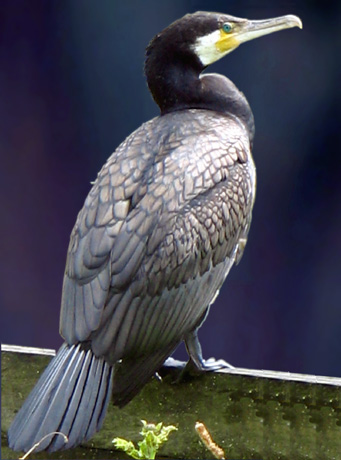| Kingdom: Animalia Phylum: Chordata Class: Aves (Birds) Order: Ciconiiformes Family: Phalacrocoracidae |
|
Great Cormorant (Phalacrocorax carbo) Great Cormorant (Phalacrocorax carbo) is a widespread winter visitor and resident in India. Identification: Size: 84-100 cm. Wingspan: 60 inches. Sexes similar. Large, dark waterbird with a long, hooked bill and long tail. Long, thin neck. Gular area pointed and yellow. White chin patch. Often perches with wings spread to dry them. Adult birds have entirely black plumage with white flank patch in breeding season. Second-year bird like adult but browner. Immature birds have pale belly with dark chest, neck and flanks.
Great Cormorant Description Length: 80-101 cm. All plumages: Bill 6.3-7.6 cm., hooked at the tip; tail with 14 feathers; feet black and fully webbed. Adults in breeding plumage: Body looks black with a bluish or greenish gloss; back feathers bronze-gray with dark borders; numerous hair-like feathers scattered over the head and neck; throat pouch yellow with wide, white hind border; patch of white on each flank, developed by early March and shed during May. Adults in winter: Similar but without the hair-like feathers on head and neck and without flank patches. Immatures: Sooty brown with whitish brown breast and belly. Breeding Nest: In colonies on cliff ledges on islands or the mainland. Composed of twigs and other coarse vegetable matter, usually including fresh seaweed; sometimes composed entirely of seaweed. Eggs: 3-7, usually 4-5; bluish white, overlaid with a chalky deposit. Laying begins during the latter part of April. Colonies of this cormorant in Nova Scotia are believed to have been established relatively recently. The first observed colony was at Crystal Cliffs, Antigonish County, where in June 1940 H.S. Peters found about 60 pairs nesting; by 12 May 1944 the colony had some 80 pairs. On 18 June 1940, I visited Bird Islands, Victoria County, and made a count of 39 occupied nests of this cormorant. A small colony I visited at Monk's Head, on the south side of Antigonish Harbour, had about 60 pairs, all appearing to be of this species; I was told by a local farmer that the colony was of very recent origin. Harrison F. Lewis visited Monk's Head on 11 June 1966 and found that the Great Cormorant colony there had ceased to exist because of erosion of the site by the sea. A Canadian Wildlife Service survey in 1971 (Lock and Ross 1973) estimated some 398 pairs of Great Cormorants on Bird Islands but only 33 pairs at Crystal Cliffs; the total population breeding in Nova Scotia was put at some 2,000 pairs out of a total Canadian population of about 2,700 pairs. The Nova Scotian population had increased about 1.5 times by 1982 (Milton and Austin-Smith 1983). Range In North America, breeds locally in the Gulf of St. Lawrence, southern Newfoundland and along the Atlantic coast of Nova Scotia; most common in Cape Breton Island. Found as far south as North Carolina in winter. Other populations breed in western Greenland; the eastern North Atlantic from Iceland to the Cape Verdes; Eurasia; and Australasia. Remarks Cormorants usually swim with their bodies submerged and only their head and neck visible I have never seen one swim with its lower back and tail above the water line. When I visited the Crystal Cliffs colony on 12 May 1944, the birds were losing their hair-like flank patches, wisps of which were lodged in the grass along the edge of the cliff; some birds had completely lost this adornment, and others retained only traces of it.
Over short distances, cormorants fly low and often in
line, one behind the other, but during prolonged flights
they often fly rapidly at considerable heights in V
formation and are frequently mistaken for wild geese,
which have a similar wing motion. In other parts of its
range, the Great Cormorant breeds and winters on both
inland and coastal waters. However, the North American
population appears to make little use of freshwater
habitats. |
| |
| Apodiformes | Bucerotiformes | Ciconiiformes | Columbiformes | Coraciiformes | Cuculiformes | ||
| Gruiformes | Passeriformes | Piciformes | Psittaciformes | Strigiformes |

